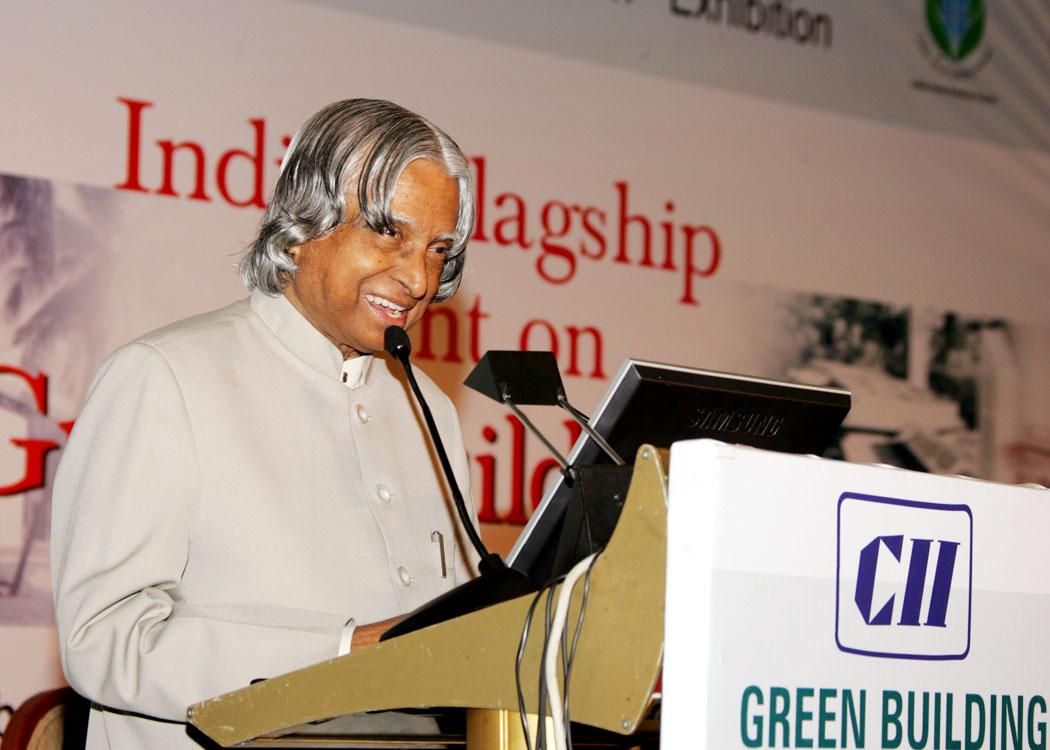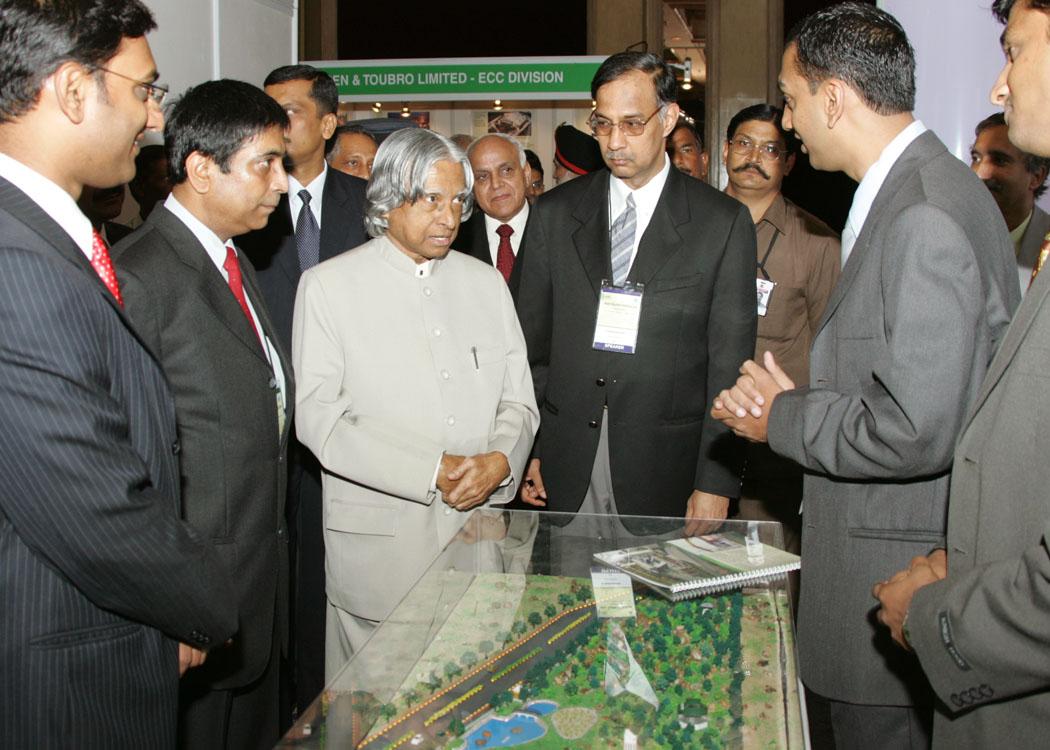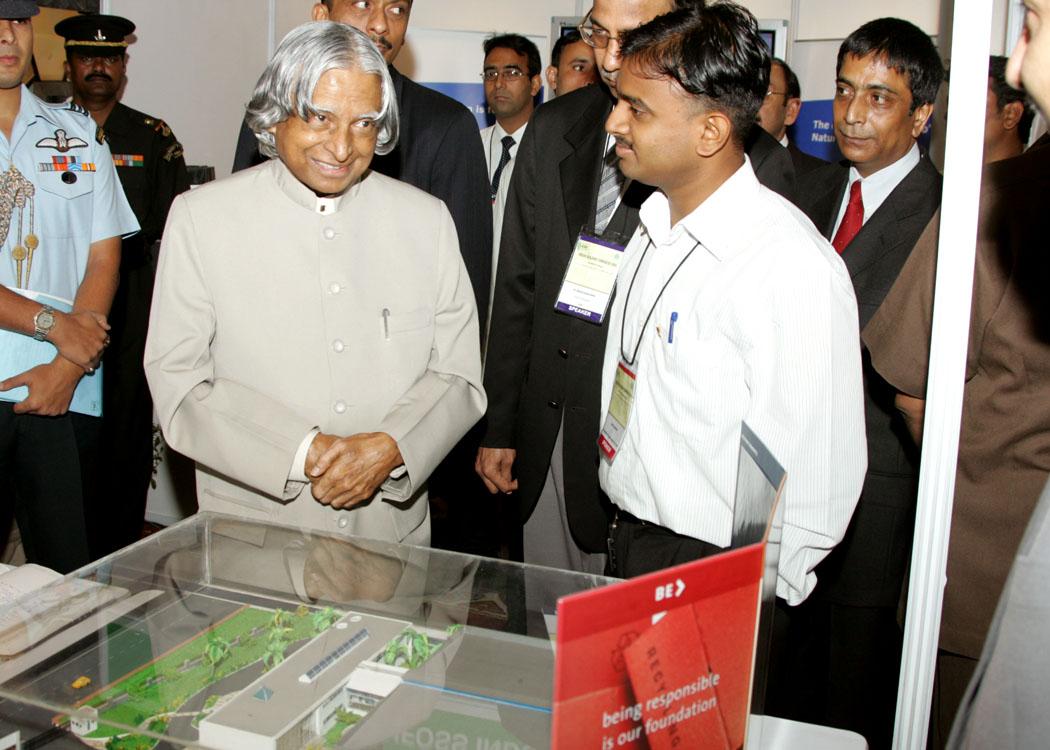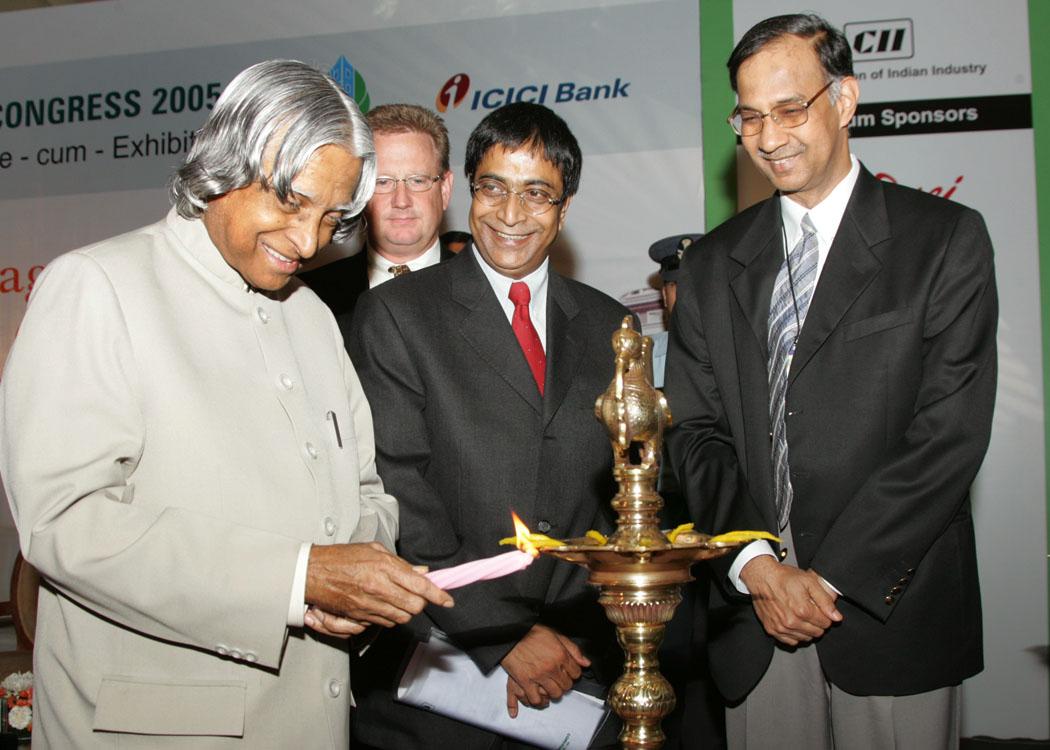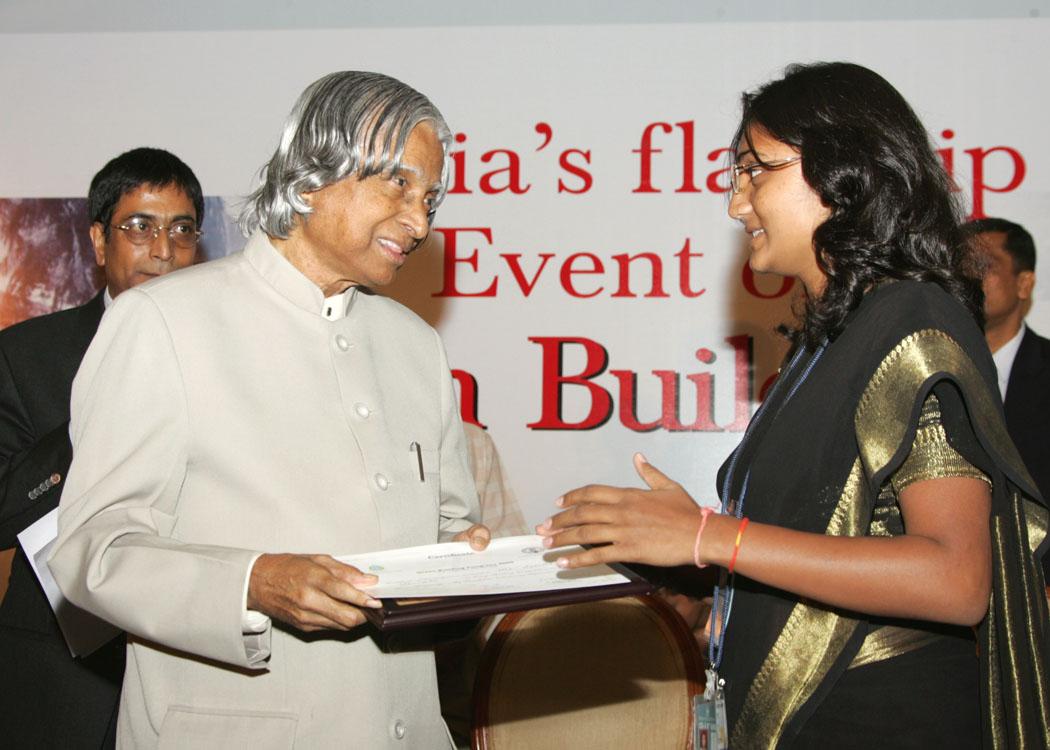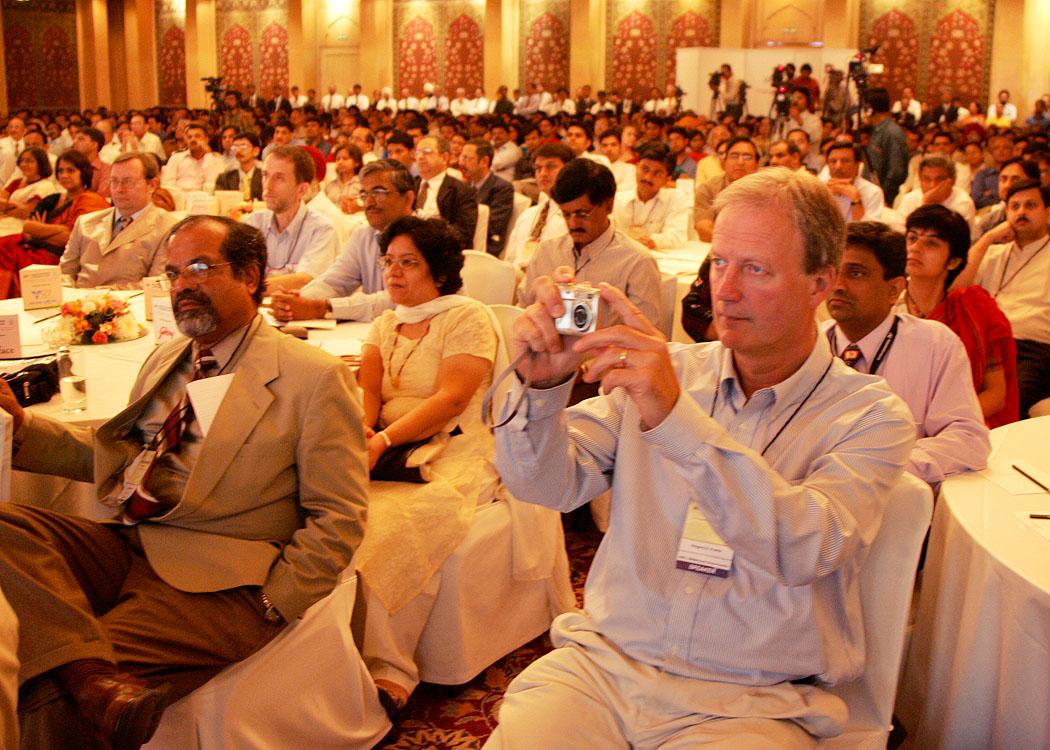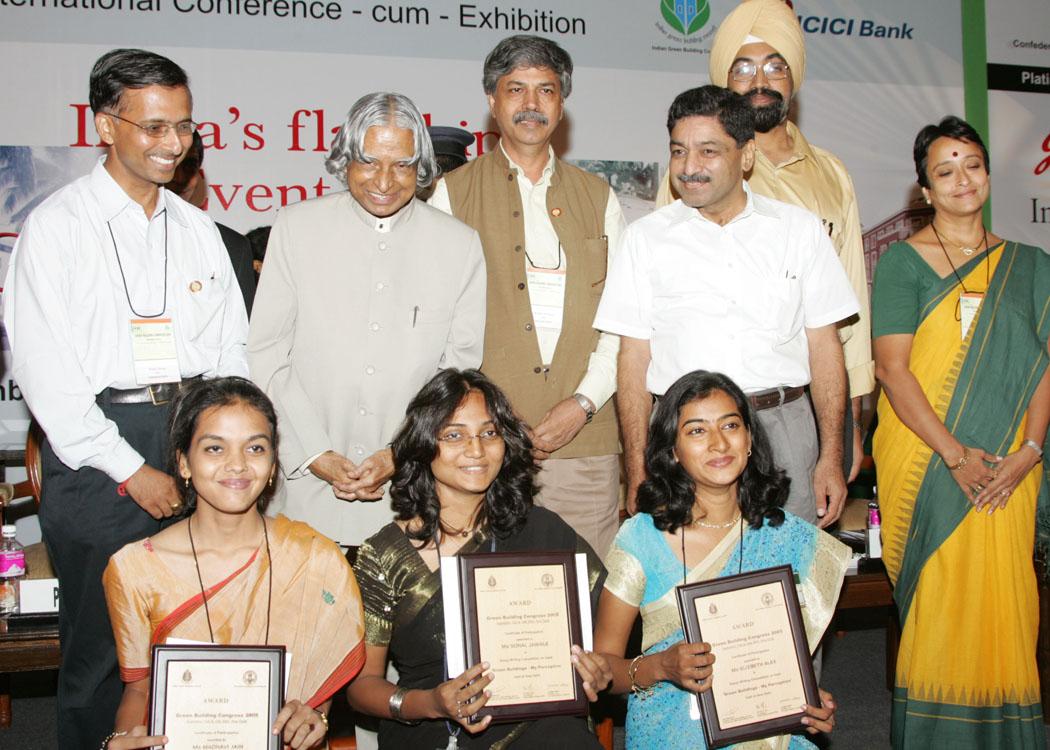Address At The Inauguration Of Green Building Congress 2005, New Delhi
New Delhi : 15-09-2005
Take the Green Tech to the people.
I am delighted to participate in the inauguration of the Green Building Congress 2005 organized by Confederation of Indian Industry (CII). My greetings to the organizers, distinguished guests and all the specialists from architecture, construction and support industries participating in this congress. This Congress is conducted at the right time since the nation is working towards energy independence and provision of adequate water supply to our people. As you succeed and grow in your green building mission, your experience will be very useful to the nation. An indicator of building a nation is its buildings. I would like to talk on the topic "Take the Green Tech to the people". Is it possible?
Energy and Water Security
Energy is the lifeline of modern societies. But today, India has 17% of the world?s population, and has just 0.8% of the world?s known oil and natural gas resources. We might expand the use of our coal reserves for some time and that too at a cost and with environmental challenges. The climate of the globe as a whole is changing. Our water resources are also diminishing at a faster rate. As it is said, energy and water demand will soon surely be a defining characteristic of our people?s life in the 21st Century.
Energy independence rests on two principles. The first, to use less energy to provide services and cut down energy losses. Simultaneously we should access technologies to provide a diverse supply of reliable, affordable, renewable and environmentally sustainable energy.
The typical features cited for Green Buildings, are noteworthy goals towards greater energy efficiency and use of renewable energies, efficient water management and above all caring for the environment. In India, the attempt towards gathering experience by practically implementing the Green buildings had already commenced. Some are already completed and many are in the pipe line. May be it is time for us to study the economic and environment viability and also share the experience on a continuing basis. This will popularize the mission of Green buildings and will one day percolate to every house that we build in our society. Will it be possible or Green Building will become, building of the high society? If it is so, I would not have been with you. I am with you because there is hope.
Energy consumption: Targets
It is reported that the total electric energy generated through various methods such as thermal, hydro, nuclear, wind and other forms in our country is about one trillion units in a year. Efforts should be made, to improve generation efficiency, to make full use of the installed capacities. Out of this only around six hundred to seven hundred billion reaches the consumer due to various technical, distribution losses. It is necessary to plug these losses. In addition our end use segments are not energy efficient either. In a growing economy when our population is expected to grow approximately at 1.3% energy consumption rate is expected to grow at 4.3% per annum. This trend would strain the energy sector to a large extent. Building sector being the major energy consumer can contribute to a large extent to discuss this issue since green buildings have the potential to save 30 to 40% energy. Some of the salient features of the Green Building are
(a) minimum disturbance to landscape and site condition
(b) buildings have to be architectured with sun and earth orbit conditions such that maximum natural light and breeze are received and minimum heating is possible
(c) use of non-toxic, recycled and environment friendly building material
(d) efficient use of water and water recycling
(e) use of energy efficient and eco-friendly equipment
(f) use of renewable energy
(g) high quality indoor air, provisions for human safety and comfort and friendly to differently challenged people
My Experience
I would like to narrate some of my experiences in Rashtrapati Bhavan. In Rashtrapati Bhavan I have two offices, one in the ground floor and the other one in the first floor. When I started working, I found that all the doors and windows with beautiful curtains were kept covered. Because of this practice, the electric lights used to be switched on, from the time I enter the office until I complete my work for the day. During my usual walk in Rashtrapati Bhavan it occurred to me that when the beautiful sun is all around, why all the doors and windows were covered with curtains and the room has been made dark. Either the intention could be that the President should not see the nature at its pure form or it is due to some security concerns. I discussed this with my teams and finally I decided to open the curtains and allow the sun light to come into my office. Once the curtains were opened the available sun light was more than sufficient for my work during the day time. Energy saving in every room is possible. Even the visitors who come to meet me notice the difference. The message is that when we design buildings we should ensure that we are able to make maximum use of the nature?s gift such as light, heat and breeze for providing the comfortable living for the occupants. In all the government buildings, we should ensure that the offices are not hidden by curtains. I had an opportunity to see a practical implementation of this in Hyderabad Green Building and in many locations in Iceland. I am happy to be talking to the experts in the evolution of the green building who have gathered here.
Renewable energy makes economic sense
Few years back the prime motivation for us to consider the renewable energy alternatives to the fossil fuel, was the concern for our environment alone, much less due to economic reasons. The recent trends in the uncontrolled increase in the cost of fossil fuels have almost nullified their economic advantage. Besides, the newer technologies such as CNT (Carbon Nano Tubes), will improve the efficiency of solar cells, the hydrogen fuel cells and many such green technologies economically very attractive as well. Rashtrapati Bhavan is considering generation of electricity from renewable resources to take care of its energy needs. One such proposal under consideration amongst many is the setting up of an 8 MGW Grid locked Solar Power Photovoltaic Plant occupying an area of 300 by 300 meters for supplying the entire Rashtrapati Bhavan Building complex including the estate. The total energy consumed presently is 10, 800 MGW hour per year. This plant apart from providing energy will reduce the dumping of carbon-di-oxide by 12,000 tons per year, 5760 Kg of sulfur oxide and 2720 kg of Harmful nitrogen oxide. The cost of the plant will be fully paid back by the saving in the electricity charges in less than 20 years.
While the world of science and technology is focusing on improving the efficiency of photo voltaic cells using nano technology through aligned CNTs to make economic sense of generation of Solar Photo Voltaic energy, many other avenues of using solar energy are also being attempted world over. One such route is to utilize the solar thermal. They use solar collectors intelligently to provide power for hot water and other heaters. In fact for lighting, fans, lifts air conditioners etc are from solar thermal. I consider the combination of the two systems may be even better than the generation of electricity from fossil fuel.
Assessment from practical experience
The factors stated above are qualitative factors. Since CII has already constructed the Green Building at Hyderabad and established all the features, it is time we make a quantitative assessment of the energy saved, water saved, pollution reduction in the atmosphere and enhancement of the efficiency of the people working in the building. Also, this building can be used as a platform for incorporating further features and experimenting before they can be applied to future green buildings.
The second building
I understand that, the second green building which has achieved Platinum rating with one lakh seventy thousand sq. feet built up area has come up in Gurgaon. It will be interesting to compare the overall performance of Gurgaon building with the Hyderabad building for generating more information which will facilitate realization of full benefits while replicating such buildings in different parts of the country. Is the Gurgaon building greener than Hyderabad? Presently, thirteen members of CII are in the process of constructing green buildings in India and in different parts of world. There is a need to motivate all the five thousand members of CII to incorporate the green building concepts in their future constructions and also mount a programme to convert their existing buildings into green buildings. This issue may be discussed in the Green Building Congress. The magnitude of energy conservation tasks are so high that we should rapidly move out of pilot systems and demonstration units. There has to be a massive time bound programme for such a conversion and introduction of Green practices into our standard building codes. Here I would like to mention about the resource efficient TERI Retreat for environmental awareness and training which has come up in Gurgaon with a energy saving of over 40%. I hope CII will take a lead by persuading its members and creating an industry which can take green building construction and conversion into major commercial activity with societal impact.
Take the Green Tech to the people.
I have one question in my mind. In our country, there are 300 million people who are in the mid income group category and about 260 million people are living below poverty line. Every one of them dreams about having a roof above their head. In order to make their dreams a reality we need about 100 to 150 million houses to be built in the next 15 years. In fact this massive construction effort will form the backbone of our economy. Today when we talk about the Green buildings, it always means a high society building or a high tech laboratory. This Green Building Congress should address how you would give the benefit of the Green technology to the middle class and below. While you are thinking of a few hundreds of high tech and high value, specialized Green Buildings, you can also think of building, millions of energy and water efficient dwellings, for the large population of the nation. While creating the building codes which include standards for Green practices, it is also important to keep in mind the special safety requirements for earthquake prone and coastal regions. I feel ?take the green tech to the people? has to be the agenda of the congress.
PURA (Providing Urban Amenities in Rural Areas) Complexes
Now I would like to move on to another important programme of rural habitat which can decongest metros and cities, thus providing excellent opportunities for energy conservation. In a sense they will be new forms of Green Habitats for India while providing also economic and social opportunities to our rural citizens. The integrated methods which will bring prosperity to rural India are: the physical connectivity of the village clusters through quality roads and transport; electronic connectivity through tele-communication with high bandwidth fiber optic cables reaching the rural areas and also through broadband wireless; knowledge connectivity through education, skill training for farmers, artisans and craftsmen and entrepreneurship programmes. These three connectivities will lead to economic connectivity through starting of enterprises with the help of banks, micro credits and marketing of the products. I see in the PURA programme potential for large scale employment generation. The integrated method envisages a mission mode empowered management structure with executive powers at the local implementation levels and by reducing the transactional costs through simplification of procedures of governance. Hence, the important element of rural development happens to be PURA. Each PURA complex will need large number of dwelling units, hospitals, educational institutions and buildings to house small and medium scale industries. It is essential to plan all these buildings using the green building concept for bringing down the recurring energy expenditure on the establishments and for the PURA household.
Training of Architects and Building Planners
Building such nationwide practices requires a large human resource and change in the mind set of the people. The architects and building planners have to play a very important role in the design of the building with the Green and safety features. The seeds of this perspective have to be sown in the schools of architecture and town planning. Energy conservation should start right from the location of the site, the direction of buildings, windows, doors and glare. The aim should be to use the sun and wind to the maximum advantage, while minimizing the wasteful heat load from sun into the buildings and roofs.
Planning for Green Building Materials
While planning for Green Buildings in all the sectors of the economy, the availability of materials and equipment will become one of the major issue. Towards this objective, there will be a need to network with several manufacturers in India to create new products and news markets. A few green materials and equipment which are available in the country are: Fly-ash cement, Fly-ash block, Recycled Aluminum, Recycled steel, Recycled tiles, Low VOC (Volatile Organic Compounds) paints, Bamboo based products, high performance glass, energy efficient equipment & systems, HFC (Hydro Fluoro Carbon) based high efficiency chillers, Building Controls, Green Roof, Recycled wood, etc., However, they are now being produced in miniscule quantities.
In addition to the above, we have to work on the development of Composting toilets, minimum water utilities, Low VOC adhesives & sealants, Carpet and Rug Institute (CRI) certified carpets, Forest Stewardship Council (FSC) Certified wood, High albedo roof paints, Building Integrated Photo Voltaic Systems, Cooling Tower Institute (CTI) certified cooling towers, Living machines (biological waste water treatment systems), etc. While developing and producing these items, we have also to work on standardization and certification of products. We need to have competent multiple agencies to enable speedy and reliable certification. The material and equipment for green buildings is an important economic activity which will generate employment of large number of our youth for the construction sector.
Suggestions for the Congress
I have a few suggestions to make for this Green Building Congress:
a. Document the experiences (both successes and problems) from the Hyderabad and Gurgaon Green buildings. This may lead to Green building code evolution and a process for the best practices. While doing so, the rating systems for Green buildings developed by The Energy and Resources Institute (TERI) including the Indian codes, standards and best practices may also be taken into account.
b. A Green Building should not only be energy and environment friendly, but also aesthetically beautiful and economically viable. A transparent cost benefit analysis will bring many people into the movement of Green building revolution.
c. The green technology of the future will have a significant component of high tech and leading edge research and development in material science and standardized manufacturing processes including the use of prefabricated structures.
d. A nationwide certification programme for the builders and architects for their green and safety awareness must be launched.
e. Water harvesting and recycling will make every building less dependent on external water supply, thus reducing the load on the town and city resources.
f. The Green Tech itself will become sustainable only when it reaches the rural population, that too to the millions in a PURA like environment.
g. The Indian Green Building Council can create a website and seek inputs from experts on traditional architectural approach to building design for long term gains and better environmental adaptations. Opinions and advise received from various agencies can be evaluated by expert teams for inclusion in the green building code.
Conclusion
The earth is a living planet. In our galaxy, earth is probably the only living planet. We have therefore a great responsibility not to hurt it. For our future generations to survive, we must be friendly to earth and lovable in taking from it.
Presently, we are generating one trillion units of power for a billion populations with certain economic strengths. And also we are using nearly 800 billion cubic meter (BCM) water both ground and surface. Our aim should be to conserve at least 10 to 15% of energy i.e. 100 billion units and 10% of water namely 80 BCM which will have a large impact on our economy. A good part of the nation?s energy is consumed by the construction industry and the house hold. By saving energy through Green buildings, we will make the air much purer to breathe. Green is safer, economically attractive and above all healthy. I would suggest that this should be the basis on which the "Green Building Congress 2005" should deliberate and prepare a decadal plan for the nation for implementation.
I am happy to inaugurate the Green Building Congress 2005 and wish the members success in their mission of making the nation green through fruitful interactive deliberations and actions.
May God bless you.

